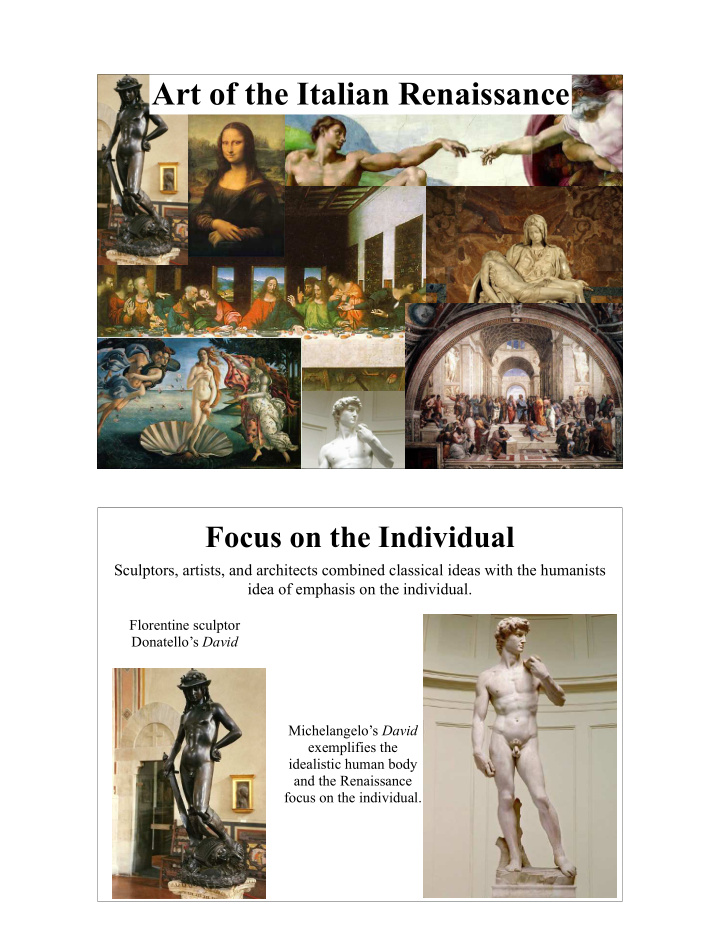



Art of the Italian Renaissance Focus on the Individual Sculptors, artists, and architects combined classical ideas with the humanists idea of emphasis on the individual. Florentine sculptor Donatello’s David Michelangelo’s David exemplifies the idealistic human body and the Renaissance focus on the individual.
Realism & Expression First nudes since classical times. Expulsion from the Garden Masaccio, 1427 Classicism The first major revival of classicism occurred during the Renaissance.
Perspective Most artists in Medieval Europe had never actually seen heaven, so the background was left to the imagination and the teachings of the church. Perspective When people became more Perspective! interested in the world around Perspective! ! them and the ideas of other people Perspective! Perspective! rather than heaven and the Perspective! teachings of the Church, Perspective! landscapes and buildings began to show up in paintings. Renaissance painters needed to be able to translate the three-dimensional world around them onto the two-dimensional surface of a painting, called the "picture plane." The solution was "linear perspective," the idea that converging lines meet at a single vanishing point and all shapes get smaller in all directions with increasing distance from the eye. Use of Light and Shadowing Chiaroscuro the use of strong contrasts between light and dark Sfumato Sfumato means “to tone down” or “to evaporate like smoke.” ! The most prominent practitioner of sfumato was Leonard da Vinci, who described sfumato as “without lines or Artemisia Gentileschi ! borders, in the manner of smoke or Judith Slaying Holofernes (1614–20) ! Oil on canvas ! beyond the focus plane.” Galleria degli Uffizi, Florence. Leonardo da Vinci ! Mona Lisa
Giotto ! Ognissanti Madonna ! 1310 ! Tempera on panel ! 325 cm × 204 cm ! Uffizi Gallery, Florence Filippo Brunelleschi ! Architect ! Cuppolo of St. Maria del Fiore ! 1436
Lorenzo Ghiberti ! East doors, or Gates of Paradise ! part of the Baptistry of Saint John in the Piazza del Duomo and the Piazza di San Giovanni, across from Basilica di Santa Maria del Fiore and the Campanile di Giotto, Florence This panel depicts the story of Joseph, including his sale into slavery, the gold cup in Benjamin's sack of grain and Joseph revealing himself to his brothers. A Contest to Decorate the Cathedral: Sacrifice of Isaac Panels Brunelleschi Ghiberti
Brunelleschi ! Crucifix ! 1410-1415 ! wooden sculpture ! Gondi Chapel of Santa Maria Novella, Florence Masaccio, The Trinity ! 1425-28 ! Fresco, 667 x 317 cm ! Santa Maria Novella, Florence
Masaccio, The Expulsion from the Garden of Eden ! 1426-28 ! Fresco, 208 x 88 cm ! Brancacci Chapel of Santa Maria della Carmine in Florence Fra Angelico Tempera on panel ! ! Deposition of Christ 176 cm × 185 cm ! ! National Museum of San Marco, Florence 1432-1434
Leonardo da Vinci, Notebooks 1476-1508 Leonardo, the Engineer Pages from his Notebook Studies of water-lifting devices. A study of siege defenses.
Sandro Botticelli, Medium oil on panel ! ! Primavera 203 × 314 cm ! ! Uffizi Gallery, Florence 1482 Leonardo da Vinci ! Virgin of the Rocks ! 1483-1486 ! Medium oil on panel ! 198 × 123 cm ! Louvre Museum, Paris
Sandro Botticelli tempera on canvas ! ! The Birth of Venus 172.5 cm × 278.9 cm ! ! Uffizi, Florence 1486 Leonardo da Vinci ! Vitruvian Man ! 1490 ! Pen and ink with wash over metalpoint on paper ! 34.4 cm × 25.5 cm ! Accademia di Belle Arti, Venice, Italy
Recommend
More recommend